
|
Glass & Porcelain Insulators |
|
|
CD 245 T-H 9200 The famed CD 245 insulator is the first glass power insulator used in the US. Installed in 1895 on the transmission line, the CD 245 was used from 1895-1989, a total of 94 years of continuous service. T-H stands for the Thomas-Houston Electrical Company and the insulator was manufactured by Brookfield in the early 1890s. T-H merged with Edison General Electric in 1892, the insulators were kept until used in 1895 on the Pelzer transmission line. Roughly 2,500 CD 245 were installed on the transmission line. Over the years the insulators were replaced, most of them survived until 1989, when many were broken for the 00 gauge copper wire. Mint blue CD 245s are valued around $60-70, minor damage or wire groove damage around $30-40 and other various forms of damage below $30. Light Green, snowy, amber or any other shades can be worth more. |
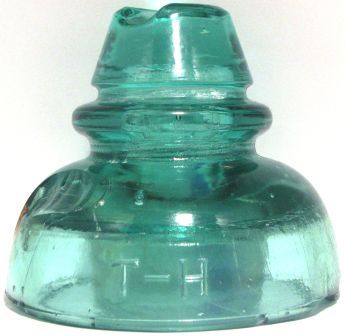 |
|
CD 287 Fred Locke The CD 287 Locke was an early replacement for CD 245 in the early 1900s. In Pelzer, it can be found with very forms of patent dates, the No. 15 style number and in shades of Aqua. Light aqua CD 287 are the earliest types while the dark aqua types were installed on distribution lines. |
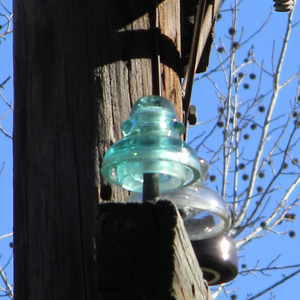 |
|
CD 280 Hemingray Hemingray made the CD 280 high voltage, triple petticoat insulator used in Pelzer in the 10s or 20s. The insulators replaced broken insulators on the transmission line and were also installed on distribution lines. CD 280 found in Pelzer come in shades of aqua, some of which have snow or amber. |
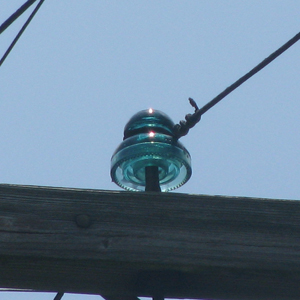 |
|
CD 280 No. 135 The rare Emerald Green CD 280 No. 135 has only been found in Pelzer on the transmission line. The insulator replaced broken insulators on the transmission line in the early 1900s. It is unknown which glass housed produced the CD 280 in Emerald Green. The Lynchburg Glass Company used the style number 135 but the deep Emerald Green color suggests the Brookfield Glass Company manufactured this product. Mint examples range from $200-300. |
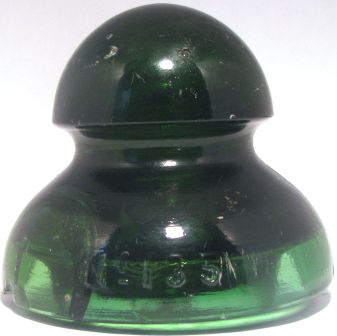 |
|
CD 232 Hemingray Clear CD 232 Hemingray D-513 insulators were manufactured by Owens-Illinois's Hemingray Division in the 1950s. CD 232 in Pelzer were installed in the 1950s on the transmission line as a replacement insulator and on distribution lines. |
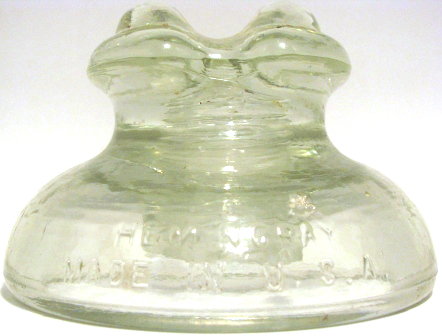 |
|
CD 162 Brookfield,
Hemingray & Star Three different glass companies manufactured the CD 162 signal style found in Pelzer. Signals with a star were most likely produced by Brookfield. The lowest crossarm on the transmission line used CD 162 Brookfield or Star for telephone and low voltage lines and on distribution lines. The Hemingray CD 162 were installed in the 10s-20s as replacements. |
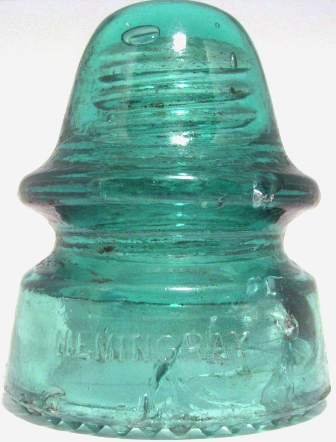 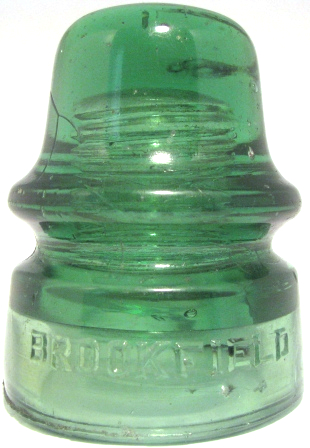 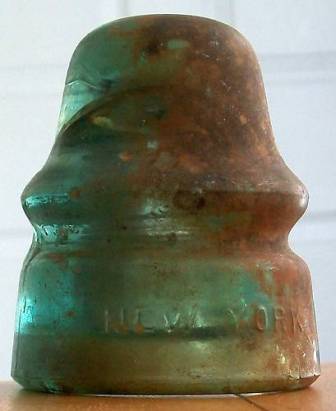 CD 162 Hemingray (Left), CD 162.1 Brookfield in Yellowgreen (Center), & CD 162.3 Brookfield (Right) |
|
CD 162.1 Brookfield A skinner signal used in Pelzer was the CD 162.1 made by Brookfield in the early 1900s. Aqua and Light Yellowgreen examples have been found on distribution lines. |
|
|
CD 162.3 Brookfield A fat signal insulator used in Pelzer was the CD 162.3. The CD 162.3 Brookfield was used on distribution lines and came in an Aqua color. |
|
|
Pittsburg Signal Signal style made by the Pittsburg High Voltage Company in the 1910s-20s. The Pittsburg signal comes in tan and brown glazes and was used as a replacement on the transmission line. |
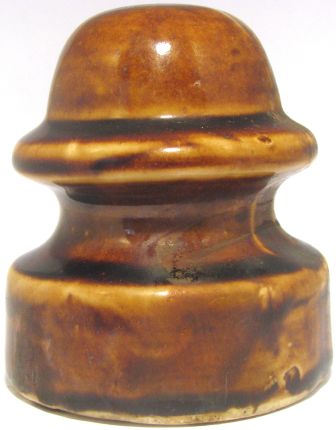 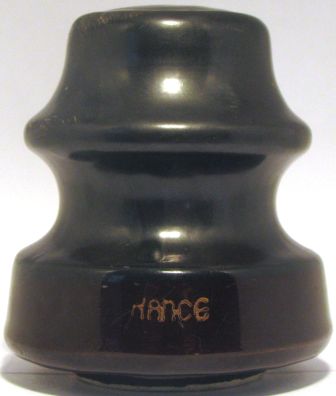 Pittsburg signal (Left) & Chance signal (Right) |
|
Chance Signal The Chance signal insulator was installed on the transmission line as a replacement insulator in the 1980s. The top of the insulator is radio treated. |
|
|
Ohio-Brass Cable Installed in the 20s or 30s as a replacement insulator on the transmission line, the OB cable insulator came in a variety of brown glazes. |
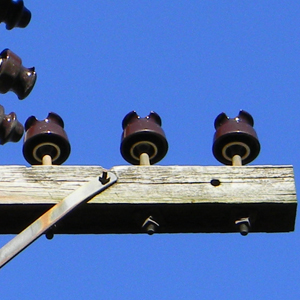 OB cable (Left) & Victor cable (Right) |
|
Victor Cable Victor cable insulators found in Pelzer replaced many CD 245 in the mid-1960s. The insulators have a date of 1963 and are brown in color. |
|
|
Locke Hi-Top The Locke Hi-Top style was popular in the 1960s and used on the transmission line as a replacement. Locke Hi-Tops from Pelzer are dated 1966 and come in White or Brown. |
|
|
Large & Small Chance
Cables The very last replacement insulator on the transmission line was in the 1980s. The Chance cable insulators with radio treated tops are found in Pelzer both large and small. |
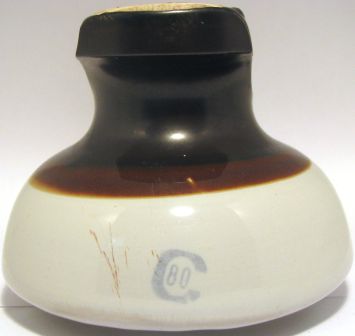 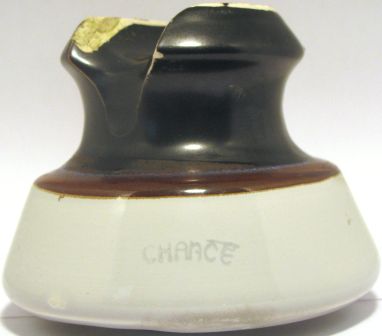 |
|
Crossarms, Brackets, Anchors & Wires |
|
|
Wood Pin Crossarm Originally installed in 1895, wood pin crossarms in Pelzer are larger then standard crossarms and use larger wood pins then most arms. Very few remain in good condition on poles because of their age and condition. |
|
|
Steel Pin Crossarm Installed in the 50s or 60s, the steel pin crossarms replaced old wood pin crossarms. Five types of steel pin crossarms are seen in Pelzer. The arms were short or long, either four or six pins. Corner poles, strained poles and tall poles were double-armed with one crossarm on each side. |
|
|
Side Pin Side pins mounted below the lower crossarm held telephone wires. Insulators used on side pins were signal types. |
 |
|
Wood Pin Nailed into crossarms, wood pins pre-date steel pins. Wood pins in surviving 1895 crossarms in Pelzer are very weathered. |
|
|
Steel Pin Steel pins have lead threads and bolted into crossarms. Steel pins found in Pelzer are made by Joslyn. |
|
|
Static Wire Crossarms In 1895, two wires on the ends of a four pin wooden crossarm was mounted at the top of the pole. For protection against lightning, every third pole on the transmission line was grounded by a copper wire running from static wires to the bottom of the pole. |
|
|
Static Wire Bracket The top crossarms on poles were later replaced by a single metal bracket holding an aluminum static wire. The oldest poles in Pelzer have a space and gain for another crossarm near the top of the pole. |
 |
|
Iron Guide Wire Anchor Corner poles, hilltop poles, tall poles, or poles under strain were guided by iron guide wires. The wires were tied under the lowest crossarm, pulled tight, and tied to an anchor buried into the ground. Anchors from 1895 were long wrought iron rods with a pointed tip that were driven deep into the ground. |
|
|
Steel Guide Wire Anchors Iron guide wire anchors became rusted out and were replaced with steel anchors. Two types of steel anchors were used in Pelzer, one was a long rod with a pointed end and another more modern type was a V shaped rod driven in by stepping on it. |
|
|
00 Gauge Copper Wire The 18 conducting wires tied to CD 245 insulators were 00 gauge wires. A very heavy wire and solid copper. Around 1989, the 00 gauge wires on the transmission line was scrapped for the copper value. |
|
|
Iron Wire Iron wire on the transmission line served several uses and came in a number of gauges. The uses were for guide wires, telephone lines, low voltage lines and tie wires. |
|
|
Arrestors, Transformers and Strains |
|
| Type | Description |
| Westinghouse Glass & Porcelain Arrestors | Used to stop lighting in lines before entering transformers. |
| GE & Westinghouse Transformers | Decreases high voltage to a lower voltage for use. |
| Ohio Brass Strain | Used on support cables to stop any flow of electricity from grounding. |
Jeffrey Kraemer. E-mail: th9200jk@aol.com

